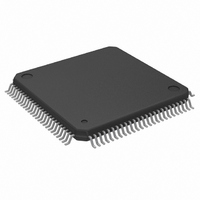HD6413007F20 Renesas Electronics America, HD6413007F20 Datasheet - Page 597

HD6413007F20
Manufacturer Part Number
HD6413007F20
Description
IC H8 MCU ROMLESS 5V 100QFP
Manufacturer
Renesas Electronics America
Series
H8® H8/300Hr
Datasheet
1.D13007F20V.pdf
(798 pages)
Specifications of HD6413007F20
Core Processor
H8/300H
Core Size
16-Bit
Speed
20MHz
Connectivity
SCI, SmartCard
Peripherals
DMA, PWM, WDT
Number Of I /o
35
Program Memory Type
ROMless
Ram Size
4K x 8
Voltage - Supply (vcc/vdd)
2.7 V ~ 5.5 V
Data Converters
A/D 8x10b; D/A 2x8b
Oscillator Type
Internal
Operating Temperature
-20°C ~ 75°C
Package / Case
100-QFP
Lead Free Status / RoHS Status
Contains lead / RoHS non-compliant
Eeprom Size
-
Program Memory Size
-
Available stocks
Company
Part Number
Manufacturer
Quantity
Price
- Current page: 597 of 798
- Download datasheet (5Mb)
19.6
19.6.1
The module standby function can halt several of the on-chip supporting modules (SCI2, SCI1,
SCI0, the DMAC, 16-bit timer, 8-bit timer, DRAM interface, and A/D converter) independently in
the power-down state. This standby function is controlled by bits MSTPH2 to MSTPH0 in
MSTCRH and bits MSTPL7 to MSTPL0 in MSTCRL. When one of these bits is set to 1, the
corresponding on-chip supporting module is placed in standby and halts at the beginning of the
next bus cycle after the MSTCR write cycle.
19.6.2
When an on-chip supporting module is in module standby, read/write access to its registers is
disabled. Read access always results in H'FF data. Write access is ignored.
19.6.3
When using the module standby function, note the following points.
DMAC: When setting a bit in MSTCR to 1 to place the DMAC or DRAM interface in module
standby, make sure that the DMAC or DRAM interface is not currently requesting the bus right. If
the corresponding bit in MSTCR is set to 1 when a bus request is present, operation of the bus
arbiter becomes ambiguous and a malfunction may occur.
DRAM Interface: When the module standby function is used on the DRAM interface, set the
MSTCR bit to 1 while DRAM space is deselected.
Cancellation of Interrupt Handling: Before setting a module standby bit, first disable interrupts
by that module. When an on-chip supporting module is placed in standby by the module standby
function, its registers are initialized, including registers with interrupt request flags.
Pin States: Pins used by an on-chip supporting module lose their module functions when the
module is placed in module standby. What happens after that depends on the particular pin. For
details, see section 8, I/O Ports. Pins that change from the input to the output state require special
care. For example, if SCI1 is placed in module standby, the receive data pin loses its receive data
function and becomes a port pin. If its port DDR bit is set to 1, the pin becomes a data output pin,
and its output may collide with external SCI transmit data. Data collision should be prevented by
clearing the port DDR bit to 0 or taking other appropriate action.
Register Resetting: When an on-chip supporting module is halted by the module standby
function, all its registers are initialized. To restart the module, after its MSTCR bit is cleared to 0,
its registers must be set up again. It is not possible to write to the registers while the MSTCR bit is
set to 1.
Module Standby Function
Module Standby Timing
Read/Write in Module Standby
Usage Notes
Rev.5.00 Sep. 12, 2007 Page 567 of 764
19. Power-Down State
REJ09B0396-0500
Related parts for HD6413007F20
Image
Part Number
Description
Manufacturer
Datasheet
Request
R

Part Number:
Description:
KIT STARTER FOR M16C/29
Manufacturer:
Renesas Electronics America
Datasheet:

Part Number:
Description:
KIT STARTER FOR R8C/2D
Manufacturer:
Renesas Electronics America
Datasheet:

Part Number:
Description:
R0K33062P STARTER KIT
Manufacturer:
Renesas Electronics America
Datasheet:

Part Number:
Description:
KIT STARTER FOR R8C/23 E8A
Manufacturer:
Renesas Electronics America
Datasheet:

Part Number:
Description:
KIT STARTER FOR R8C/25
Manufacturer:
Renesas Electronics America
Datasheet:

Part Number:
Description:
KIT STARTER H8S2456 SHARPE DSPLY
Manufacturer:
Renesas Electronics America
Datasheet:

Part Number:
Description:
KIT STARTER FOR R8C38C
Manufacturer:
Renesas Electronics America
Datasheet:

Part Number:
Description:
KIT STARTER FOR R8C35C
Manufacturer:
Renesas Electronics America
Datasheet:

Part Number:
Description:
KIT STARTER FOR R8CL3AC+LCD APPS
Manufacturer:
Renesas Electronics America
Datasheet:

Part Number:
Description:
KIT STARTER FOR RX610
Manufacturer:
Renesas Electronics America
Datasheet:

Part Number:
Description:
KIT STARTER FOR R32C/118
Manufacturer:
Renesas Electronics America
Datasheet:

Part Number:
Description:
KIT DEV RSK-R8C/26-29
Manufacturer:
Renesas Electronics America
Datasheet:

Part Number:
Description:
KIT STARTER FOR SH7124
Manufacturer:
Renesas Electronics America
Datasheet:

Part Number:
Description:
KIT STARTER FOR H8SX/1622
Manufacturer:
Renesas Electronics America
Datasheet:

Part Number:
Description:
KIT DEV FOR SH7203
Manufacturer:
Renesas Electronics America
Datasheet:











